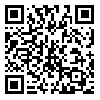BibTeX | RIS | EndNote | Medlars | ProCite | Reference Manager | RefWorks
Send citation to:
URL: http://ijpcp.iums.ac.ir/article-1-2419-en.html
2- Faculty of Education and Psychology, University of Isfahan
3- دانشگاه اصفهان
Objectives: The present study has been performed with the aim of designing and evaluating the psychometric properties of Autism Spectrum Disorders Diagnosis Scale (ASDDS). Method: This study is an instrumental and validity evaluation. The statistical community of the research consisted of all children with autism spectrum who live in Isfahan. Among them, 100 patients were selected by method of convenient sampling, and also their mothers or trainers were asked for responding the scales of study. The tools of data gathering included demographic information and a researcher-made scale named Autism Spectrum Disorder Diagnosis Scale (ASDDS) according to reversion of DSM-5. Also, Giliam Autism Rating Scale (GARS) and Children Autism Rating Scale (CARS) were used for evaluating the concurrent validity. Results: The results of the psychometrics of the scale indicated appropriate content, convergent and diagnostic validity, and internal consistency as well as the scale stability over the time. The correlation coefficient between sub-scales showed very high correlation between the sub-scales. The results obtained from the confirmatory factorial analysis indicated that the DSM-5 model is appropriate for scale. In addition, the general reliability of the scale by using of Cronbach's alpha was 0.88. Conclusion: the results demonstrated that Autism Spectrum Disorder Diagnosis Scale (ASDDS) is a suitable tool for diagnosing autism spectrum disorders based on DSM-5 in children and adolescents.
Received: 2016/01/3 | Accepted: 2016/01/3 | Published: 2016/01/3
| Rights and permissions | |
 |
This work is licensed under a Creative Commons Attribution-NonCommercial 4.0 International License. |



